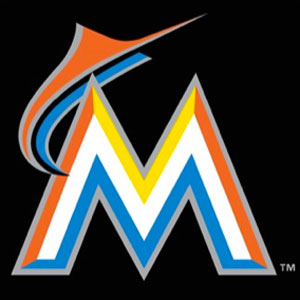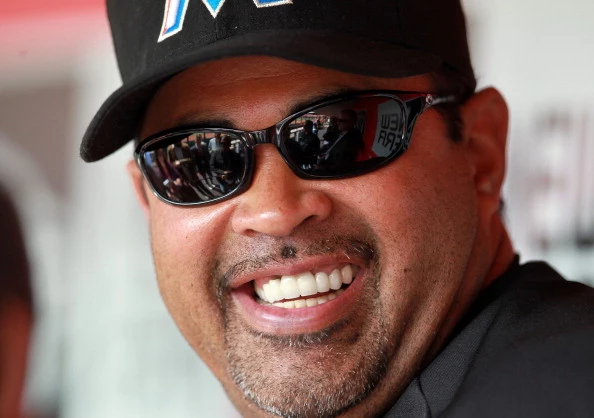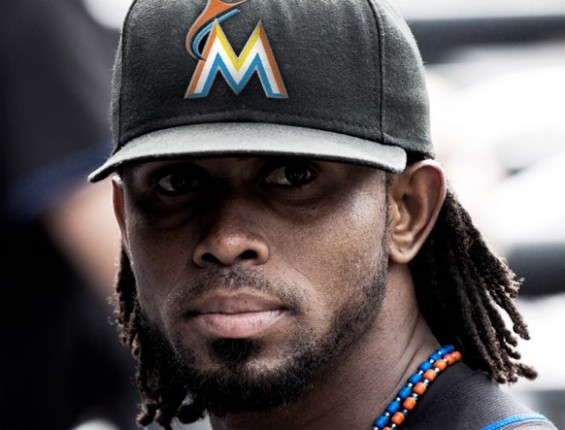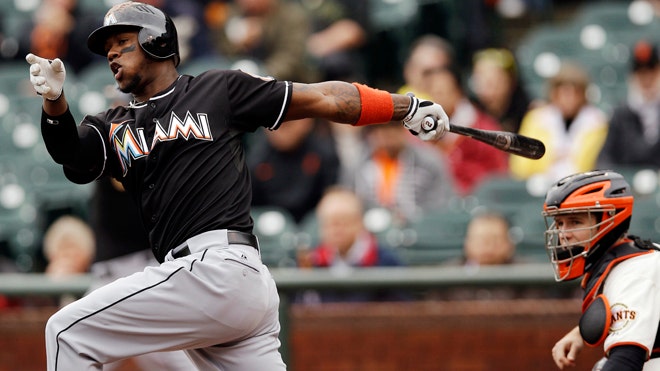Last year, the Florida Marlins languished into one of the
forgotten clubs of Major League Baseball.
They finished with a 72-90 record; a mere 30 games behind the NL East
winning Philadelphia Phillies. The fans
weren’t necessarily behind their team either as seen by the average attendance
that was barely an arm and a leg above 19,000 (19,007
to be exact). Barely reaching
19,000 fans per game put the Marlins in the solid position of 29th out of 30
major league ball clubs. Something had
to be done.
The Marlins brass had a plan. Getting out of the dump that was Sun Life
Stadium was step number one for the organization. That was covered with the new $500 million+
Marlins Park that was opened on opening day of the 2012 season. It was new. It was bold. It was located in Little Havana, the perfect
location to reach that strong Latino following.
They changed their name from the Florida Marlins to the Miami
Marlins.

To go along with the change of name, the team needed a
change of color. The team decided on a
bold new color scheme of red-orange, yellow, blue, black, and white. It was new.
It was hip. It was the new thing
to wear. Merchandise
sales rose.

Of course, the team needed a fiery new manager that would
burn just as hot as that red-orange highlighted “M” on the Marlins’ cap. Ozzie Guillen was the logical choice after
burning a rift so deep that the White Sox could not wait to move him along. To make the choice in manager even better,
Guillen relates well with the Latino community due to his Venezuelan heritage (let us ignore Ozzie’s Fidel Castro
gaffe. We can chalk that up to “Ozzie
being Ozzie”.).

Last but certainly not least, the bold new Marlins made the
bold offseason moves that were seemingly needed to make the team a
contender. They went down to the wire in
talks with free agent superstars Albert Pujols and CJ Wilson. The Marlins went bigger than ever before in
the franchise’s history by signing Jose Reyes, Mark Buehrle, and Heath
Bell. The team jumped its payroll from
just above $57 million in 2011 to a club record $118 million in 2012.

The Miami Marlins seemed to have rebranded themselves as a
winner in a state of the art ballpark. The
hype machine was certainly churning as the 2012 season approached. This team was bold and brash and brazen just
as the planned wanted them to be. Things
were finally looking up. Well, things
were looking up on paper at least.
As the trade deadline looms, a mere four days away, the
Marlins seem to be in the midst of another of their infamous fire-sales due to
being 13.5 games back of the division leading Washington Nationals (as of Wednesday 7/25). In the wee hours of the morning on Wednesday,
the Marlins traded Hanley Ramirez, the face of their franchise (or at least he was supposed to be), to
the Los Angeles Dodgers for a very underwhelming package of minor
leaguers. The key point of the deal, you
may ask? The Dodgers agreed to pick up
all of the rest of Ramirez’s contract (in
typical Marlins fashion).
The worst part is that Hanley Ramirez may not be the only
player traded. Anibal Sanchez and Omar Infante were traded to the Detroit Tigers earlier in the week. Right handed power
pitcher Josh Johnson is rumored to be getting shopped around by the team. It is most likely safe to assume that a
contract like Jose Reyes’s isn’t safe come 4pm July 31st either.

So what is actually wrong with the Marlins being sellers at
the deadline? Major league teams do it
each and every year, so what really is different? The Marlins organization tried to build a
brand; a brand of a winning ball club. However,
the Marlins’ suits seem to have forgotten that plans for rebranding a
professional baseball team and building a championship team don’t happen
overnight. They certainly do not happen
in the course of one season either. These
things take time. Half of one Major
League Baseball season isn’t exactly enough time.
It seems that the Marlins are panicking. Attendance at the new Marlins Park is the lowest
among first year stadiums in the past three decades. The team is selling off franchise caliber
players. In the process of their
deadline dealings, the Marlins are alienating their fan base. By the way, this is a fan base that has cost the team well over a
billion dollars when stadium, merchandise design, and player contracts are
considered. Then to go sell out on those
fans that the team worked so hard to earn just because the team isn’t in the
playoff hunt? Have some patience! This is the reason that players are signed to
long term contracts anyway. Instead of
creating more holes by trading away able-bodied and able-minded major league
players for prospects, shouldn’t the current holes on the team be filled? The first year of not only a new stadium but
an entire organization wide rebranding effort as well is paramount to sustained success. The organization must commit to the plan, not
give up on it half way through year one.
People will argue and point to the team’s World Series championships
in 1997 and 2003. Yea, those are great,
but we are about 10 years past that. Frankly,
this team is poorly run and it comes from team owner Jeffrey Loria at the
top. His typical style has been to be bold
for a little while and then to fizzle out for a longer while. This time, the Marlins gave up too
quickly. The team will be lucky to
retain any significant amount of fans after this season. The Marlins may have a different home, a different
look, and different players on the field, but this team is just what they have
always been: a disgrace to Major League Baseball.

No comments:
Post a Comment